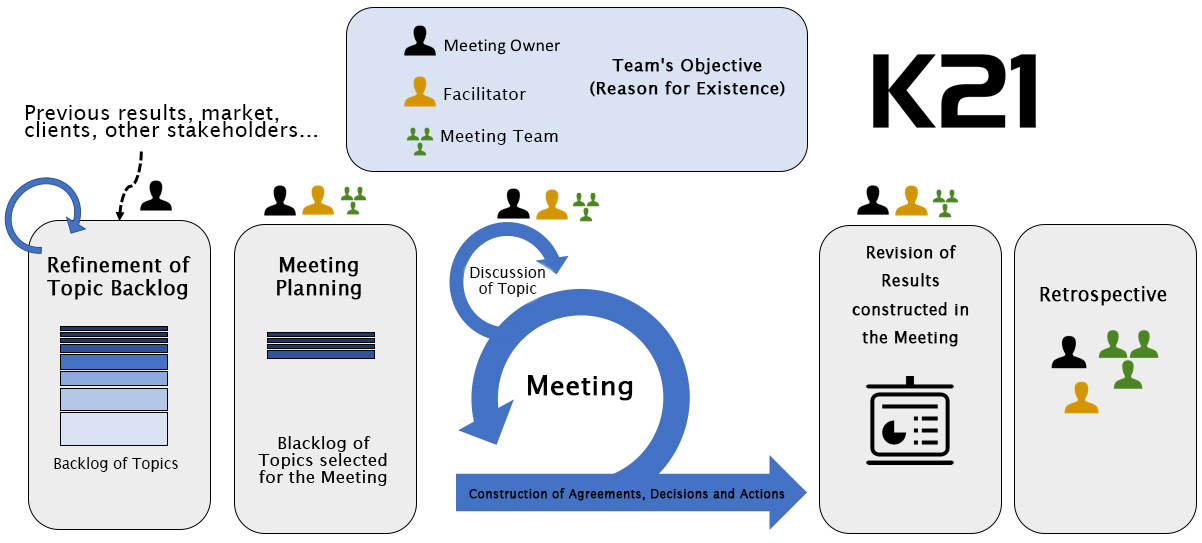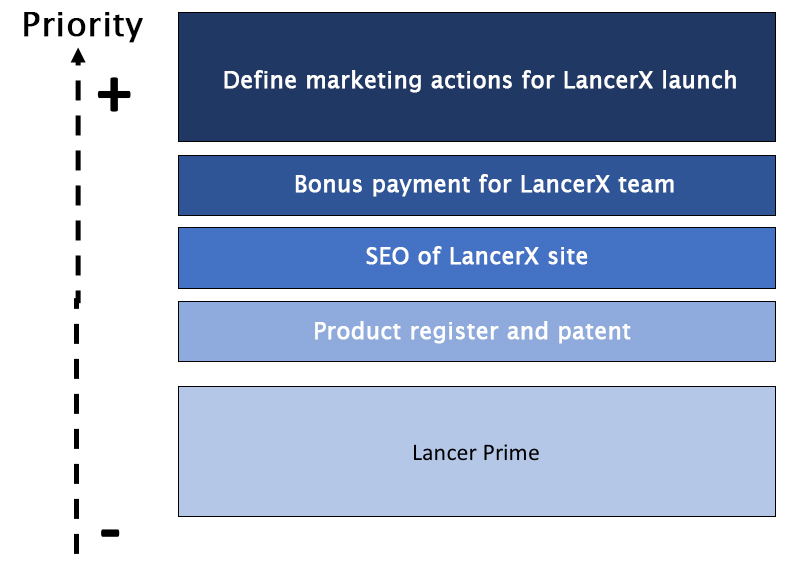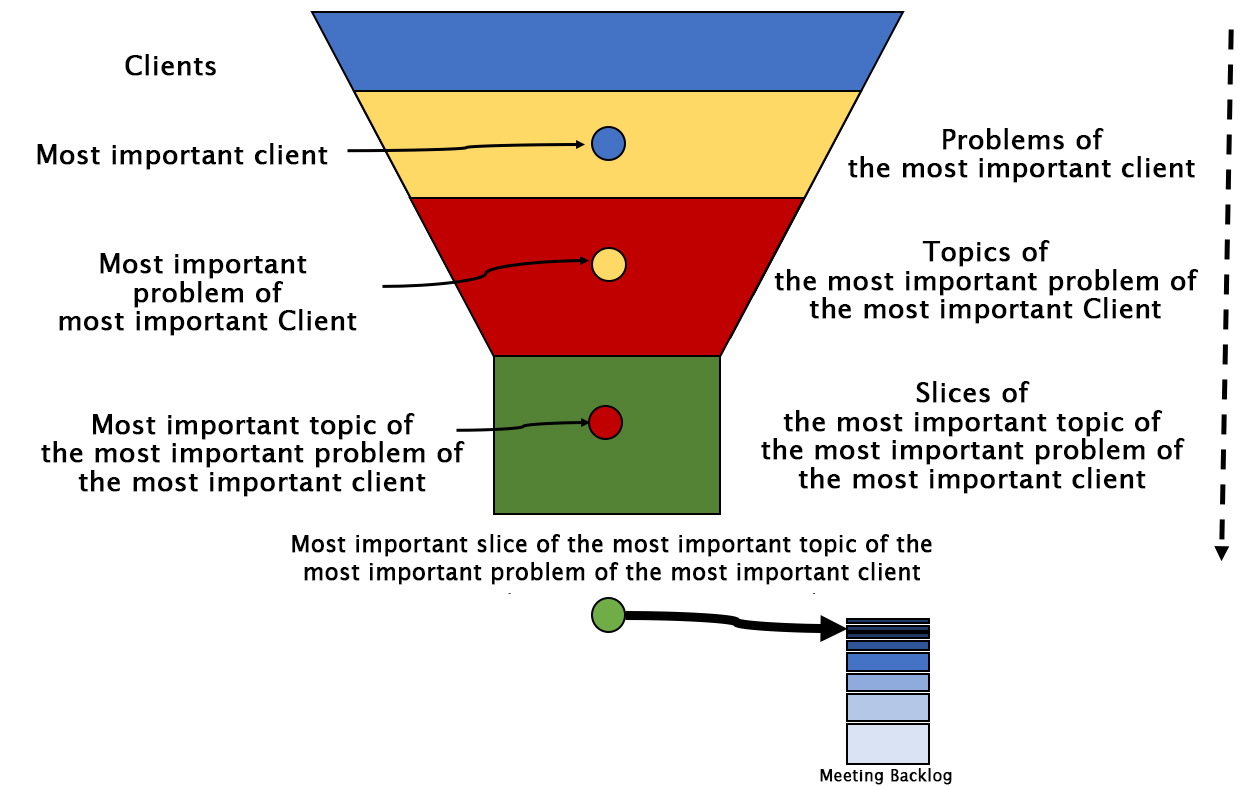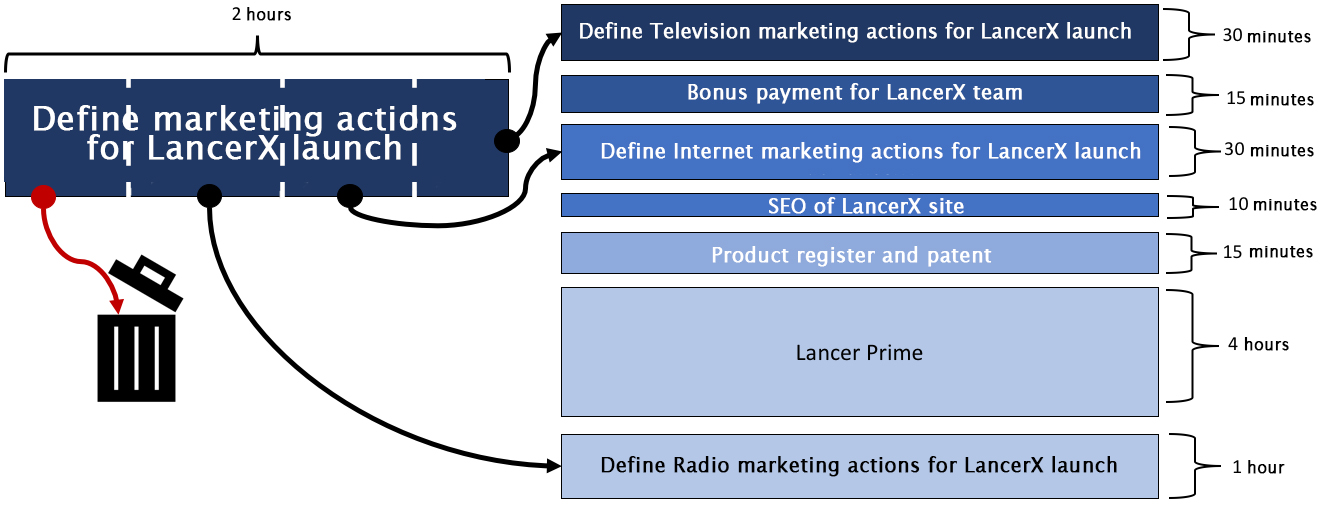Have you ever been in meetings in which:
- a lot was discussed but nothing decided;
- someone said: “Let’s deal with the little 5-minute matters first and then the more important ones.”
- topics ranged from company aims for the next quarter, to the final score of Sunday’s match;
- you thought to yourself: “What am I doing here?”;
- you went to the restroom, got a coffee, checked your cell phone and the discussion still hadn’t moved on;
- it took so long that people starting “fleeing” through the door, into their notebooks or phones;
- the first activity was arranging the next meeting;
- a combination of all of the above.
We hold so many inefficient meetings and very often aren’t aware of this. Let’s see how we can use Scrum to make meetings more fluid, participative and useful.
Adapting Scrum to Meetings

Clear objective and Meetings aimed at results
When you invite people to a meeting, have a clear objective and state what result should be reach by the end. For example, if the group’s objective is to put together the company’s strategic plans, by the end, we’ll EMERGE with a version of the strategic plan. There may be several meetings before we have a strategic plan ready to be published by the company, but at each we’ll have a deliverable plan.
Roles
Just like in Scrum, some roles are fundamental.
Meeting Owner
In Scrum, the Product Owner (PO) is responsible for maintaining in the backlog the items necessary for building the product. In the meeting we need a Meeting Owner to maintain the meeting’s topics in the Backlog of Topics. He will be responsible for:
- refining what topics can be dealt with in future meetings;
- prioritizing topics;
- slicing topics which take longer or which may even go beyond the time set for the meeting, into smaller but still relevant topics;
- discarding topics which have become irrelevant.
Facilitator
This is the meeting’s Scrum Master, a neutral person who conducts the meeting without getting into the discussions. His/her attributes are:
- ensuring the meeting’s infrastructure is available;
- ensuring that the results are written down (he/she doesn’t need to be the secretary);
- controls the time-box (or facilitates the decision of who will do this) of the topics and the meeting;
- prevents people from losing the focus;
- ensures that the team’s agreements in the meeting are respected;
- facilitates the Retrospective.
Meeting Team
It’s no use inviting a multitude of people to make a decision. Crowded meetings drown in inefficiency, neverending discussions and indecision. Have a cohesive group made up of people who are relevant to the discussion. The Scrum concept of a team made up of 7 + or – 2 members can also be applied to meetings.
It is fundamental that you invite the people who can really contribute to a solution to the problem. Explain and make explicit the importance of each person who is being invited.
Have a Prioritized Backlog of Topics
The characteristics of the Backlog of Topics is the same as a product backlog. New topics which couldn’t be dealt with can be added to a next meeting, others may lose their priority and even be discarded, and many will be sliced in order to fit into a meeting.
Example of a Meeting’s Backlog of Topics:

Backlog Prioritizing Topics for Meetings
Define the team’s agreements
Start each meeting visiting and updating the agreements of the Meeting Team (workgroups, committees, groups). The agreements serve to increase the meeting’s efficiency and keep it within the Time-box (more on this below). For example: the meeting starts on time regardless of the number of participants, or the meeting only starts when X members are present; we’ll respect the time-box of topic discussions; the decisions we take will be recorded in the xpto file, etc.
The important thing is that these agreements are not “over-prepared” before the meeting. They should emerge from the Team taking part.
Have the Meeting
At the start of the meeting, have the participants estimate how long they think they’ll need to discuss each topic in the backlog. We use the scale based on Fibonacci, similar to Story Point: 5 minutes, 10 minutes, 15 minutes, 30 minutes, 1 hour, 2 hours, 4 hours and 8 hours.

Backlog Prioritizing and Estimate of Meeting Topics
Slicing Topics
If you have a topic with a discussion estimate of four hours and the meeting is only two hours long, the Meeting Owner will have to slice the topic in order for it to fit in the meeting. A good guideline for this is: we want to discuss the topic’s most important Point of the most important problem of the most important client.

Funnel for Slicing Backlog Items
Based on the estimate and priority given by the Meeting Owner, we’ll have the Backlog of Topics Selected for the Meeting.
An example of slicing and reprioritization of topics Backlog:
 Example of Topic Slicing and Discarding
Example of Topic Slicing and Discarding
The Meeting
With the Backlog of Topics Selected for the Meeting created, it’s time for the meeting to take place.
Using a Time-box is fundamental.
If the time for discussing a topic is unrestricted, it will expand and we’ll probably go beyond the time set for the meeting to end.
We like to go into meetings with 2 timers: one marking the total meeting time and the other the time estimated for the topic under discussion.
May we go beyond the time-box to discuss an important topic?
We like to have the team make an agreement in this situation: if the topic is interesting and the facilitator perceives that the estimated time-box will run out, we can extend the time. However, this is limited to up to double the initial estimate.
For example: The topic define Television marketing actions for the product launch was estimated at 30 minutes. If it is interesting and there is a consensus that we should continue to discuss this topic, we can do so for another five, 15 or at the most 30 minutes beyond the estimated time (total 1 hour of discussion).
This stops the conversation from dragging on indefinitely with no solution, and still also allows other topics to be dealt with in the meeting. It is worth highlighting that we’re spending a little more time on the highest priority topics. If the meeting is over before all items in the backlog are broached, then we’ll have talked about the most important ones.
Results beyond Meeting Minutes
Minutes are usually a headache. Normally, someone is made responsible for typing them up after the meeting. This person may not have time and the minutes will take ages to be written. Once the person responsible manages to write the minutes, the pilgrimage begins to get all the signatures. People will have gone on vacation, others are always in meetings, or left the company and other mishaps. When you finally get all the signatures, the last person to sign notices that an essential piece of information was omitted and the whole process starts over.
Avoid the homework of writing up the minutes
As we wrote at the beginning of this article, instead of having minutes filled with things to do, in a meeting to define marketing actions, create a script, elaborate a strategic plan, and at the end of the meeting you’ll have a version, albeit initial, of these items. If anyone asks what point the work has reached, we can show the results and not a page filled with intentions.
But the company requires the taking of minutes
One model we like to adopt is to record the meeting in a PowerPoint file (or similar, even Dontpad.com) projected for all. The first slide is the title and meeting or group’s objective. The second is the Backlog of Topics. The third is the team agreements. For the fourth onwards we use the meeting slides. The title is the date of the meeting and the topics are the subjects dealt with and actions planned for each topic.
As the PowerPoint is projected for all present and can easily be shared with everyone, we can present it as a team agreement without the necessity for signatures.
Adapt this practice to your restrictions
If your company still requires a standard of documents, or if the signature of participants is essential, project the document to everyone during the meeting, print it and get the signatures as soon as the meeting is over and the people are present. DON’T TAKE WORK HOME.
Revision of results
Put aside 5 minutes of the meeting to revise the results the team has achieved in the meeting.
Retrospective: Continuous improvement of your company’s meetings
Put aside another 5 minutes for the retrospective. Discuss what was good or could be improved in the next encounter. Any topic the participants find pertinent: the process of invitation and people chosen, topics which went on too long, results achieved etc.
Our experience
We’ve used this format for meetings in various types of company. From Petrobras to Peixe Urbano, via banks, insurance firms and Startups. Feedback is always positive and most of the teams adopt this format and perfect it with the company’s specific arrangement.
And take a look at our blog with various facilitation techniques: Facilitation Techniques. Want to exchange ideas about how to make your team work even more efficient? Take part in one of our training.
